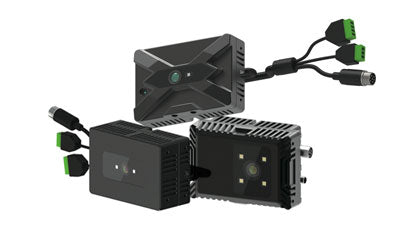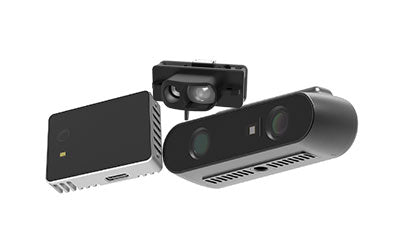ToF vs LiDAR: Which 3D Sensor Tech Is Best for Smart Automation

ToF and LiDAR Sensors: How Do I Choose the Best 3D Technology for My Automation System?
In intelligent devices, autonomous driving, and industrial automation systems, TOF (Time-of-Flight) (ToF) and LiDAR (Light Detection and Ranging) are the two most widely used 3D sensing technologies. Both rely on optical principles to measure distances, yet they differ significantly in range, imaging method, cost structure, and system integration. This article will provide an in-depth analysis of ToF vs LiDAR, explore fusion trends, and guide system designers and 3D sensing companies on how to choose the optimal solution for different application scenarios.
1. Definition and Distinction: The Core Differences Between ToF and LiDAR
In today’s 3D sensing and spatial computing landscape, ToF sensors and LiDAR systems are the most commonly referenced depth-sensing technologies. Although both are based on the principle of 'time of flight,' they differ significantly in design objectives, detection range, scanning method, and application fields. Understanding these differences helps device manufacturers and developers make smarter decisions in product selection and system integration.
1.1 What is ToF? — Short-Range 3D Depth Sensing Technology
A ToF (Time-of-Flight) sensor calculates the distance to an object by measuring the time it takes for a light pulse to travel to the target and back. Its working principle is simple yet efficient:
-
Emitter (typically VCSEL lasers) sends near-infrared pulses.
-
Receiver (SPAD photodetectors) measures the flight time to calculate precise depth information.
Mainstream ToF modules on the market include:
-
STMicroelectronics ToF Sensors
-
Infineon REAL3 3D ToF Sensors
-
Texas Instruments (TI) Time-of-Flight Sensors
-
Sony DepthSense / PMD 3D ToF Camera Modules
Key characteristics of ToF sensors:
-
Short-range sensing: Typically from a few centimeters up to several meters
-
High frame rate and real-time response: Capable of capturing hundreds of frames per second
-
Compact and low power: Ideal for smartphones, IoT devices, and wearables
-
Stable performance in various environments: Works reliably under low light or complex illumination
Typical ToF applications:
-
Smartphone 3D cameras: Portrait blur, 3D modeling, gesture recognition
-
Face ID and security systems: Liveness detection and precise facial matching
-
AR/VR spatial awareness: Accurate alignment of virtual objects with the real world
-
Robotics and smart locks: Obstacle detection, distance measurement, and contactless interaction
In short, ToF sensors provide devices with spatial awareness, bridging the gap from 2D vision to 3D intelligence.
1.2 What is LiDAR? — Long-Range High-Precision Spatial Scanning
In comparison, LiDAR (Light Detection and Ranging) systems are more complex and offer higher precision. LiDAR emits fast-scanning or multiple laser beams to create 3D point cloud maps, reconstructing the surrounding environment with high accuracy.
LiDAR working types:
-
Mechanical LiDAR: Rotating mirrors scan 360° around the device
-
Solid-State LiDAR: Uses MEMS or flash technology for miniaturization and reliability
-
Hybrid LiDAR: Combines mechanical and electronic scanning for a balance of precision and speed
LiDAR advantages include:
-
Long-range detection: Distances up to hundreds of meters
-
High-precision spatial mapping: Generates millions of points for detailed 3D maps
-
All-weather performance: Works reliably in day/night, fog, and challenging environments
-
Supports SLAM (Simultaneous Localization and Mapping): Enables autonomous navigation and mapping
LiDAR is widely used in:
-
Autonomous vehicles
-
Industrial surveying and SLAM mapping
-
Smart city monitoring and security systems
-
High-precision robotics and drone navigation
Limitations: High cost, larger size, higher power consumption, and complex algorithms—better suited for long-range or industrial-grade applications.
1.3 Core Comparison: ToF vs LiDAR
| Comparison Dimension | ToF Sensor | LiDAR Sensor |
|---|---|---|
| Detection Range | 0.1m – 5m (short-range) | 10m – 300m (long-range) |
| Sensing Mode | Full-frame depth map | Scanning point cloud |
| Response Speed | Millisecond-level real-time | Millisecond-level, depends on scanning system |
| Accuracy | Medium-high (mm–cm level) | High (mm level) |
| Power & Size | Low power, compact | High power, larger size |
| Cost | Relatively low, mass-producible | High cost |
| Typical Applications | Smartphones, AR/VR, Face ID, smart locks, IoT devices | Autonomous driving, SLAM, industrial surveying, drones, security systems |
In short: ToF = short-range, high-speed, compact, low-power; LiDAR = long-range, high-precision, scanning-based, costly.
1.4 Application Domains: Consumer vs Industrial Deployment
-
ToF focuses on consumer electronics:
Smartphones, AR glasses, smart locks, and home robots—providing real-time depth for HMI and spatial recognition. -
LiDAR leads industrial and automotive applications:
Its high-precision point cloud capabilities make it essential for autonomous vehicles, delivery robots, and drone surveying.
With miniaturization, short-range LiDAR and high-precision ToF are beginning to converge. For example, some vendors offer Flash LiDAR, combining LiDAR’s accuracy with ToF’s real-time response—a promising approach for 3D vision and spatial computing.
1.5 Conclusion: Complementary, Not Competing
Although ToF and LiDAR are often compared, they are not mutually exclusive—they serve different layers of spatial awareness:
-
In consumer electronics, mobile devices, and smart homes, ToF dominates due to its low cost and low power.
-
In autonomous driving, industrial inspection, and mapping, LiDAR remains irreplaceable for long-range, high-precision detection.
Looking ahead, with AI, computer vision, and multi-sensor fusion, ToF and LiDAR may co-exist in the same system, forming a 'Spatial Intelligence Engine' that drives the evolution from 2D vision to full 3D perception.
2. Application Scenarios Comparison: Indoor ToF vs Outdoor LiDAR
| Application Field | ToF Sensor Advantages | LiDAR Advantages |
|---|---|---|
| Smartphones & Consumer Electronics | Compact, low power, suitable for ToF 3D cameras | High cost, not ideal for mass production |
| Industrial Automation / Robotic Arms | High-speed ranging, short-range collision avoidance, posture sensing | Enables long-range spatial scanning |
| Smart Home / IoT Devices | ToF proximity sensors enable contactless operation | Larger size, higher power consumption |
| Autonomous Driving / Robot Navigation | Short-range obstacle sensing with fusion | Strong long-range 360° environment mapping |
In short, ToF excels in consumer electronics and short-range sensing due to cost-effectiveness and easy integration, while LiDAR remains the core sensor for autonomous driving and industrial SLAM systems.
3. Performance Comparison: Resolution, Range, Cost, and Interference Resistance
-
Resolution
-
ToF Sensor Resolution typically ranges from VGA to QVGA (320×240 to 640×480)
-
LiDAR offers higher point cloud density, achieving millimeter-level spatial accuracy
-
-
Detection Range
-
ToF Range typically 0.1–10 meters
-
Long-Range LiDAR can exceed 200 meters, suitable for high-speed environments
-
-
Cost and Power Consumption
-
ToF modules are low-cost, compact (e.g., 3D ToF Module or ToF Sensor Camera) and suitable for large-scale deployment
-
LiDAR is expensive, requires complex maintenance, but irreplaceable in long-range 3D sensing applications
-
-
Interference Resistance
-
ToF Depth Sensors can be affected by strong ambient light
-
Solid-State LiDAR uses multi-point sampling and filtering algorithms to enhance stability
-
4. Fusion Trends: ToF + LiDAR + Camera / Radar Systems
Integration Trend: ToF, LiDAR, Camera, and Radar Fusion in 3D Sensing
With innovations from 3D sensing technology companies such as STMicroelectronics, Infineon, ON Semiconductor, and Texas Instruments in ToF sensors, LiDAR, RGB cameras, and mmWave radar, single-sensor solutions increasingly cannot meet the demands for high-precision, wide-coverage, multi-scenario adaptability.
Modern intelligent systems require devices to detect short-range gestures and HMI interactions, while simultaneously performing long-range environment scanning and obstacle detection, with robustness under complex lighting and environmental conditions. Therefore, multi-sensor fusion (Sensor Fusion) has become a core trend in 3D sensing.
4.1 ToF + LiDAR: Full-Space Sensing from Near to Far
ToF + LiDAR sensor fusion combines the strengths of both technologies, achieving end-to-end spatial perception:
-
ToF short-range advantages: High frame rate, low power, ideal for gesture recognition, facial recognition, and close-range obstacle detection
-
LiDAR long-range advantages: High precision, long-distance scanning, suitable for autonomous driving, robot navigation, and environment mapping
-
Fusion value: Enables devices to perceive both near-field user actions and far-field environment layouts, enhancing safety and reliability in autonomous driving, smart home security, and robotic collision avoidance
4.2 ToF + RGB Camera + AI Algorithms: Depth and Texture Fusion
In 3D image sensor systems, combining ToF depth data with RGB camera-captured texture and AI algorithms achieves more accurate and natural perception:
-
Depth + texture fusion: Enhances realism in AR/VR, allowing virtual objects to integrate naturally with the real environment
-
AI-enhanced recognition: Uses depth maps and RGB images as input to AI models for complex gestures, facial expressions, human motion, and object recognition
-
Applications: AR/VR interactions, smart lock liveness detection, automated retail product recognition, robotic grasping and manipulation
This fusion enables consumer devices to not only see object positions but also understand shape, material, and dynamic behavior, achieving intelligent spatial awareness.
4.3 ToF + mmWave Radar: Enhanced Environmental Robustness
In low-light, night-time, or foggy conditions, single optical sensors may be limited. Fusing ToF sensors with mmWave radar significantly improves environmental robustness:
-
mmWave radar advantages: Penetrates dust, smoke, and low-light environments, providing reliable object detection
-
ToF advantages: Provides precise short-range depth information
-
Fusion value: Achieves all-weather perception, supporting autonomous driving assistance, security monitoring, and intelligent logistics robots
4.4 ToF + IMU + AI Chip: Dynamic Gesture Recognition & Spatial Tracking
By combining Inertial Measurement Units (IMU) with AI chips, ToF enables complex dynamic interactions:
-
IMU sensors provide acceleration, angular velocity, and orientation
-
ToF sensors provide precise depth and spatial positioning
-
AI algorithms classify actions, recognize gestures, and predict spatial trajectories
-
Applications: Full-body motion capture in wearables, VR/AR immersive games, smart home gesture control, industrial robot operation monitoring
With multi-modal fusion, devices not only 'see' actions but also understand user intent, enabling truly natural interaction.
4.5 Market Trends and Outlook
-
Multimodal sensing is becoming a core growth driver in the 3D sensing technology market
-
Modular sensor solutions (ToF + LiDAR + Camera + Radar) reduce integration costs and improve mass-production efficiency
-
AI and edge computing integration enables low-latency real-time spatial perception
-
Consumer-to-industrial convergence: Applications span smartphones, AR glasses, smart homes, autonomous vehicles, robots, and smart cities
ToF + LiDAR + Camera / Radar fusion is an inevitable trend in 3D sensing, enhancing device perception in complex environments and providing strong support for AIoT, intelligent interaction, autonomous driving, and industrial automation.
5. System Design Recommendations: Choosing and Balancing Fusion Strategies
For OEM/ODM manufacturers and system architects, designing a 3D sensing system requires consideration of:
-
Scene distance and ambient lighting
-
Indoor short-range, low-light → ToF Depth Camera / 3D ToF Sensor
-
Outdoor long-range, high-speed → LiDAR System / Long-Range ToF Sensor
-
-
Cost and power trade-offs
-
Consumer devices → prioritize low-power ToF sensor modules
-
Industrial/automotive solutions → consider hybrid LiDAR + ToF designs
-
-
Privacy and data security
-
ToF outputs only depth data, not identifiable images, facilitating privacy protection and edge computing deployment
-
-
Supply chain and ecosystem support
-
Choose mature 3D sensor module vendors (e.g., Infineon, ST, TI, ON Semiconductor) to reduce integration risk
-
6. Future Outlook: Towards Intelligent Spatial Awareness
Over the next five years, 3D ToF sensors and solid-state LiDAR will continue to integrate. Market research indicates the 3D sensing technology market will grow at a CAGR of over 15%, with trends including:
-
ToF 3D camera modules becoming core components in smartphones and IoT devices
-
LiDAR systems serving as “spatial radar” in autonomous driving, smart cities, and security
-
Semiconductor 3D sensor manufacturers (e.g., Infineon Technologies AG, STMicroelectronics) driving SoC integration
-
AI + 3D depth sensing enabling true machine spatial intelligence
Future automation systems will not only 'see' but also 'understand space', achieving a leap from 2D visual recognition to full 3D spatial awareness.
-
Posted in
CS20P






